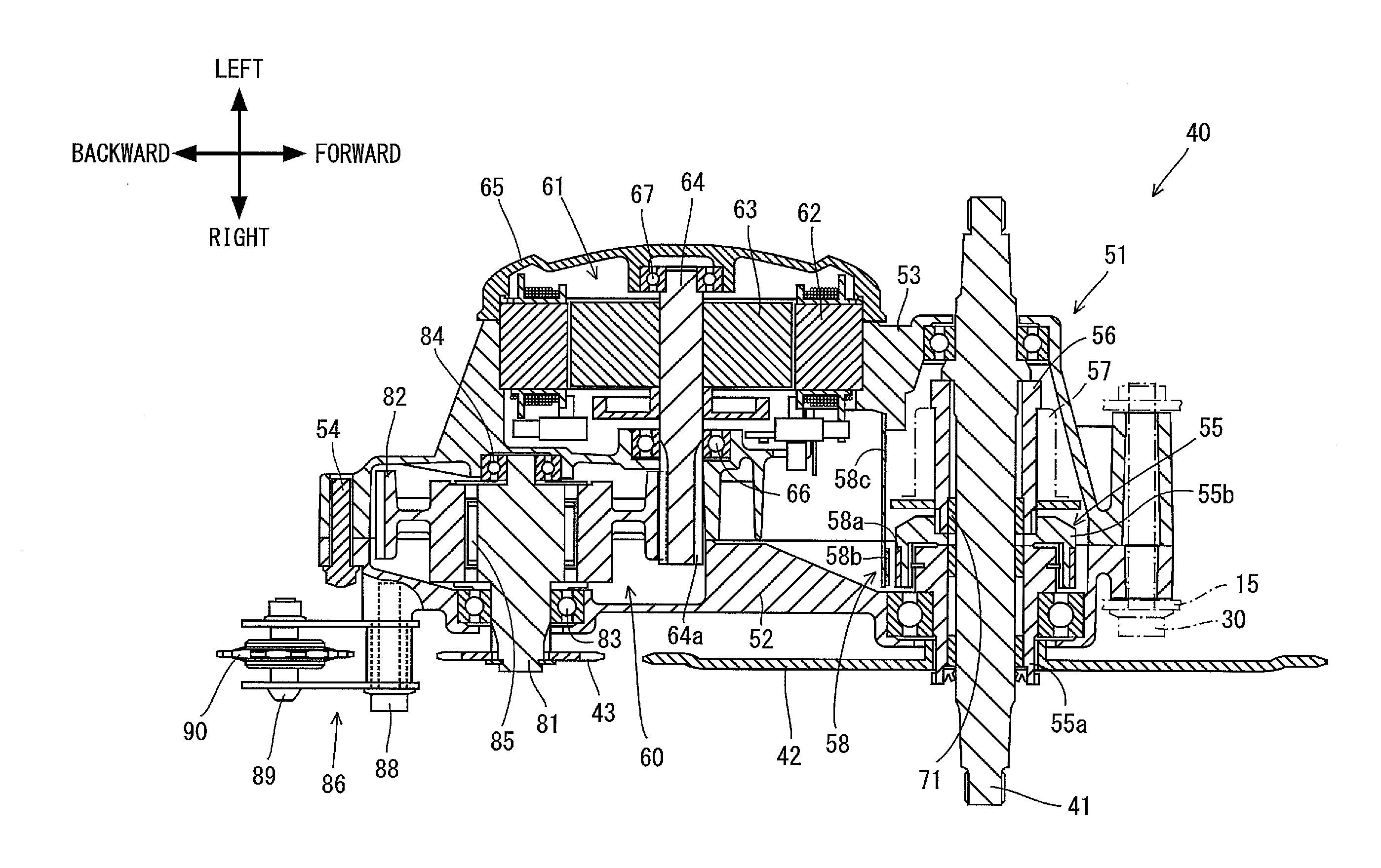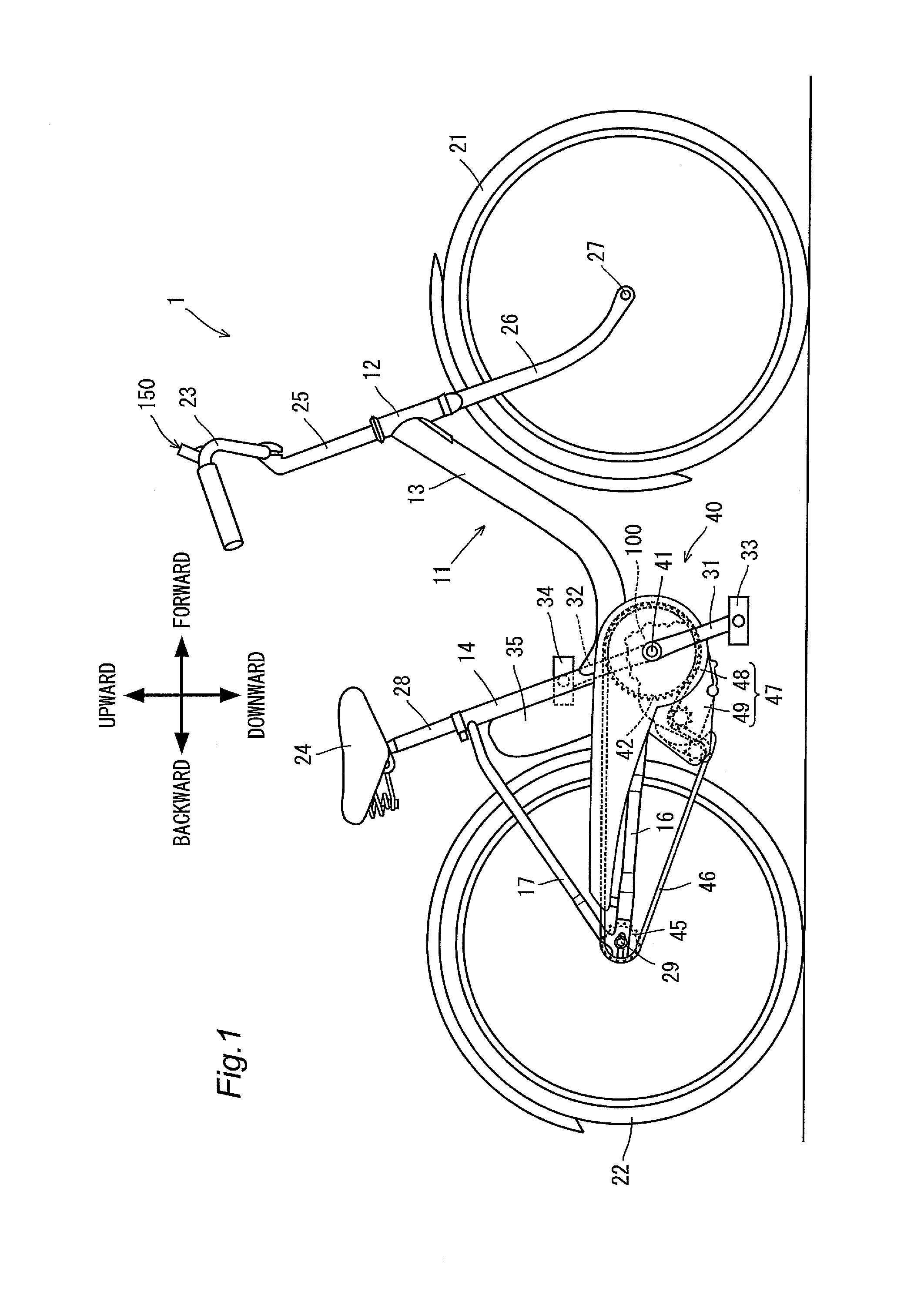Driving unit and battery-assisted bicycle
- Summary
- Abstract
- Description
- Claims
- Application Information
AI Technical Summary
Benefits of technology
Problems solved by technology
Method used
Image
Examples
first preferred embodiment
[0030]FIG. 1 shows a general structure of a battery-assisted bicycle 1 according to a first preferred embodiment of the present invention. FIG. 2 shows a general structure of a driving unit 40 and a driven sprocket 45 of the battery-assisted bicycle 1. As will be described, in this battery-assisted bicycle 1, a pedaling effort generated by a rider pushing on pedals 33 and 34 (see FIG. 1) is assisted by providing a driving force output by an electric motor 61 (see FIG. 3). More specifically, the battery-assisted bicycle 1 includes a driving mechanism that assists the pedaling effort in addition to a general structure as a bicycle.
[0031]As shown in FIG. 1, the battery-assisted bicycle 1 includes a vehicle body frame 11 that extends in a front-back direction. The battery-assisted bicycle 1 includes a front wheel 21, a rear wheel 22, the handle 23, the seat 24, and the driving unit 40.
[0032]The vehicle body frame 11 includes a head pipe 12, a down frame 13, a seat frame 14, a bracket 15...
second preferred embodiment
[0106]FIG. 8 is a flowchart for illustrating sensor failure determination for a battery-assisted bicycle according to a second preferred embodiment of the present invention. The sensor failure determination flow according to the second preferred embodiment is different from the failure determination flow according to the first preferred embodiment in that a rotation speed of the crankshaft 41 obtained from a determination result by the crank rotation detector 58 is compared to a value in a prescribed range with respect to an estimated rotation speed. In the following description, the same elements as those according to the first preferred embodiment are designated by the same reference characters and their description will not be provided while only elements different from those according to the first preferred embodiment will be described.
[0107]Steps SC1 to SC3, SC6, and SC7 in the flow in FIG. 8 are the same as steps SA1 to SA3, SA5, and SA6, respectively, in the flow in FIG. 6 ac...
third preferred embodiment
[0118]FIG. 9 shows a general structure of a sensor failure detector 120 in a battery-assisted bicycle according to a third preferred embodiment of the present invention. The structure according to the third preferred embodiment is different from the structure according to the first preferred embodiment in that its sensor failure detector 120 includes a timer 121 to count an abnormality detection duration and a detection duration determination unit 122. In the following description, the same elements as those according to the first preferred embodiment are designated by the same reference characters and their description will not be repeated while only elements different from the first preferred embodiment will be described.
[0119]As shown in FIG. 9, the sensor failure detector 120 includes the timer 121 (duration measuring unit) and the detection duration determination unit 122. The sensor failure detector 120 preferably has the same structure as that of the sensor failure detector 1...
PUM
 Login to View More
Login to View More Abstract
Description
Claims
Application Information
 Login to View More
Login to View More - R&D
- Intellectual Property
- Life Sciences
- Materials
- Tech Scout
- Unparalleled Data Quality
- Higher Quality Content
- 60% Fewer Hallucinations
Browse by: Latest US Patents, China's latest patents, Technical Efficacy Thesaurus, Application Domain, Technology Topic, Popular Technical Reports.
© 2025 PatSnap. All rights reserved.Legal|Privacy policy|Modern Slavery Act Transparency Statement|Sitemap|About US| Contact US: help@patsnap.com



